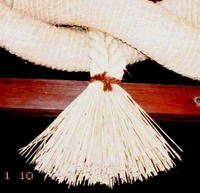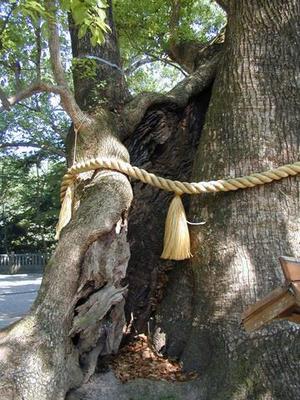. shimenawa - legends .
:::::::::::::::::::::::::::::::::::::::::::::::::::::::::::::::::::::::::::::::::::::::::::::::::::::
Shimenawa 注連縄 a sacred rope
You see them at the entrance to a holy place, usually a Shinto shrine, to mark the entry into a sacred area. They are also around sacred trees.
Simplicity was the essence of the earlier Shinto shrines in Japan. The natives believe that the Japanese kami (gods) inhabit all natural phenomena such as volcanoes and rocks; these sacred places were thus marked with only a shimenawa (special plaited rope) and gohei (strips of white paper). The shimenawa will lead one to fences and on to the torii gates, which are now common features of a shrine.
I have written about the gates (torii) to a Shinto shrine here:
. Torii 鳥居
Gate of a Shinto Shrine

The Great Shimenawa at Izumo Shrine
. Join the Shimenawa friends on facebook ! .
:::::::::::::::::::::::::::::::::::::::::::::::::::::::::::::::::::::::::::::::::::::::::::::::::::::
kigo for early winter
shime tsukuri 注連作 (しめつくり) making sacred ropes
... shime nau 注連綯う(しめなう)
They are prepared for the New Year decorations. Many farmers make small ones for their home entrances and local shrines.
kigo for the New Year celebrations
these ropes are renewed to make sure the area is purified and stays that way for the coming year. There are also smaller ropes for the home shrine (kamidana) or the Tokonoma in a private home.
shimekazari 注連飾 (しめかざり)
kadokazari 門飾 かどかざり)
toshinawa 年縄(としなわ)
wakazari 輪飾(わかざり) round straw wreath
kazarinawa 飾縄(かざりなわ), nawakazari 縄飾り(なわかざり)
kazariwara 飾藁(かざりわら)
maedarejime 前垂注連(まえだれじめ)
wajime 輪注連(わじめ)round straw rope
daikonjime 大根注連(だいこんじめ)in the form of a radish
. . . CLICK here for Photos !
goboojime 牛蒡注連(ごぼうじめ)in the form of a burdock root
. . . CLICK here for Photos !
shime morai 注連貰 (しめもらい)collecting straw rope decorations
Children go around before the "little New Year" on January 15 to collect the straw decorations for buring at a common pile, Sagichoo 左義長(さぎちょう).
Dondoyaki どんど焼 and sagichoo, burning of decorations
For more about HUMANITY KIGO look here at the New Year
WKD : New Year, shinnen shin nen 新年
:::::::::::::::::::::::::::::::::::::::::::::::::::::::::::::::::::::::::::::::::::::::::::::::::::::
Some English Links dealing with this Shimenawa:
In Japan, shimenawa (sacred twists of ricestraw rope) can be as small and light as a feather or weigh over 3,000 pounds. They signify a sacred or newly purified space, especially when hung over doorways.
There is some more light information about the Shimenawa.
http://www.swarthmore.edu/Humanities/pschmid1/array/convolute3/shimenawa.html
A rope similar to the shimenawa is also worn by yokozuna, the highest ranked sumo wrestlers, during ritual ceremonies.
Short Information about Shinto Shrines:
http://www.japan-guide.com/e/e2059.html
xxxxxxxxxxxxxxxxxxxxxxxxx
A great LINK about Asian Rice Cultures
Over the centuries, rice has sculpted the culture of Asia. It is the grain that links Heaven and Earth, mortals and gods. Wherever the crop has been planted, festivals, traditions, rituals, and languages celebrate its importance. Even for those for whom rice is an everyday sight, something magical—spiritual—still radiates from the depths of the green fields.
Ceremonies, Rituals, and Festivals
Rice in Greetings, Meanings, and Symbolism
Medicinal Uses of Rice
Rice Landscape
Rice in the Weave
RiceWorldThe world’s only museum dedicated exclusively to rice.
Mountains of Rice: Beauty and Toil
Photos with Shimenawa / Philippines
http://www.asiarice.org/sections/gallery/gallery6-3.html
http://www.asiarice.org/sections/riceheritage/riceheritage.html
xxxxxxxxxxxxxxxxxxxxxxxxxxxxxxxxxxxxxxx
The Japanese Group for the Study of the Shimenawa
has an extensive site with all the anwers we could wish for. I will use it to show you more pictures and more explanations. Make sure you go to the pages mentioned and see the many examples given.
.. .. .. .. Shimenawa around a tree
... ... ... Shimenawa from Iwaki Shrine, Tsugaru
- source : simenawa.org/
. . . CLICK here for "simenawa" Photos !
Different forms of the hangers

http://www2s.biglobe.ne.jp/~auto/SIDE.html#SIDE.html

. Tsuruoka mingei 鶴岡民芸 folk art from Tsuruoka .
Yamagata
:::::::::::::::::::::::::::::::::::::::::::::::::::::::::::::::::::::::::::::::::::::::::::::::::::::::
. Yakubyoogami 疫病神 Yakubyogami, Deity of Diseases .
eyami no kami えやみのかみ
gyooyakujin 行疫神 gyoyakujin
ekijin, yakujin 疫神
Many villages hung a sacred rope (shimenawa) in front of the village entrance to keep him out.
:::::::::::::::::::::::::::::::::::::::::::::::::::::::::::::::::::::::::::::::::::::::::::::::::::::::
Some Pictures
Shimenawa (Sacred Rope) Naminoue Shrine, Naha City
http://www.pbase.com/image/25059964

Camphor Tree Kusunoki 楠木 くすのき
ein heiliges Seil
schmueckt die Gottheit -
tausend Jahre Leben
Gabi Greve
:::::::::::::::::::::::::::::::::::::::::::::::::::::::::::::::::::::::::::::::::::::::::::::::::::::
paper and straw -
the new year starts
with a clean slate

Gabi Greve, January 2007
:::::::::::::::::::::::::::::::::::::::::::::::::::::::::::::::::::::::::::::::::::::::::::::::::::::
又ことし七五三かける也顔の皺
mata kotoshi shime kakeru nari kao no shiwa
another year
hanging the New Year's rope...
wrinkled face
Tr. David Lanoue
. Kobayashi Issa 小林一茶 in Edo .
:::::::::::::::::::::::::::::::::::::::::::::::::::::::::::::::::::::::::::::::::::::::::::::::::::::

Futamigaura 二見ヶ浦 by 伊東深水 Ito Shinsui (1898 - 1972)
皆拝め二見の七五三を年の暮
mina ogame Futami no shime o toshi no kure
please all, worship this !
the sacred rope of Futamigaura Beach
at end of the year
Written at the end of the year 1688 元禄元年師走.
It was the hokku for a kasen 歌仙 with many of his disciples, including Sora.
In the room was a hanging scroll with the view of the "Wedded Rocks of Futamigaura" 二見が浦 夫婦岩.
Meoto Iwa 夫婦岩 "Wedded Rocks", can be found on many beaches in Japan, even in Ise.
They are venerated as a symbol for a good couple enduring all the hardships over the years.
shimenawa 七五三縄 not: shichi go san nawa
- - - - - There is another hokku by Basho about the scroll of Futami in Ise:
Worshiping at Futamigaura
うたがふな潮の花も浦の春
utagau na ushio no hana mo ura no haru
doubt it not:
the blossoms of the tide also show
spring upon this bay
Tr. Barnshill
Do not doubt it,
The bay has its spring too,--
The flowers of the tide.
Tr. Blyth
Written in 1688 元禄元年.
Basho wrote about the rocks of Ise. 三重県度会郡二見町二見浦.

. Matsuo Basho 松尾芭蕉 - Archives of the WKD .
quote
Because the sunset over the Sea of Genkai is so beautiful, Futamigaura Beach in Fukuoka is known as “Futamigaura of the Sunsets”. It is also called Sakurai Futamigaura Beach, as the two rocks lying close to one another just off the coast that are connected with a sacred straw rope are owned by Sakurai Shrine, and were venerated by the Kuroda domain lord for generations.
source : crossroadfukuoka.jp

source : zelda0726
:::::::::::::::::::::::::::::::::::::::::::::::::::::::::::::::::::::::::::::::::::::::::::::::::::::
hidarinawa, hidari-nawa 左縄 sacred rope for a shrine
twisted with the left hand on top of the right.
miginawa, migi-nawa 右縄 for daily use
Normal straw ropes for the farmers are twisted with the right hand on top.
:::::::::::::::::::::::::::::::::::::::::::::::::::::::::::::::::::::::::::::::::::::::::::::::::::::
. Miyazaki Folk Art 宮崎県 (Miyasaki) .
Shimenawa of all kinds and shapes
. warazaiku 藁細工 things made of straw
:::::::::::::::::::::::::::::::::::::::::::::::::::::::::::::::::::::::::::::::::::::::::::::::::::::
- - - Walther Sell wrote :
The Japanese characters for ‘shimenawa’ are 注連縄。The meaning of the characters are respectively
注 — attention, 連 — connect and 縄 — rope.
The meaning of ‘shimenawa’ can be seen as ‘a spiritual rope connecting one`s attention’.
This means the attention of uninterrupted self-awareness.
Behold now, what a wondrous order and what a wondrous sequence that has an obvious imprint of celestial wisdom. Thus was completed our God-created prayer as a threefold and unbroken cord, wisely and intelligently, braden and woven. -- Philokalia , Monks Callistus and Ignatius
Hold fast to the rope of God, all of you, and do not split up. -- The Koran
Breath is the essence of performance. It is like to thread that connects a set of jewels. The words are like jewels, the breath like a string. -- Komparu Zenchiku, 15th c, Japanese Noh actor
You must have the mind and the breath constantly following one another, the attention and the breath always guarded together. You need only cause them to be lengthened continuously and unbroken - like a silken thread which is never let loose. -- Yuyan Commentary on Cantong Qi (Triplex Unity)
Separation of God is like being in a well; remembrance of Him is the rope. -- Shams
See also: https://japanesesymbolsofpresence.com/shinto.html
:::::::::::::::::::::::::::::::::::::::::::::::::::::::::::::::::::::::::::::::::::::::::::::::::::::

. Join the Shimenawa friend on facebook ! .
. shimenawa - legends .
[ . BACK to WORLDKIGO TOP . ]
[ . BACK to DARUMA MUSEUM TOP . ]
- #shimenawa #shimekazari -
:::::::::::::::::::::::::::::::::::::::::::::::::::::::::::::::::::::::::::::::::::::::::::::::::::::







